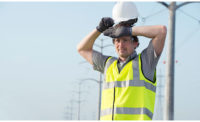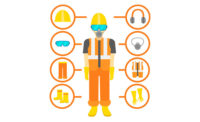Garney Construction, a Kansas City, Missouri-based construction company specializing in water and wastewater construction, is preparing for another hot summer of work around the U.S., including in the humid southeast, dry desert, and sunny Midwestern cities. This year, the company’s safety programs for preventing heat stress, which can lead to injuries and fatalities on the job, will be different and better than the year before. That’s because, during the summer of 2020, Garney trialed a new continuous monitoring smart PPE system, comprised of sensors worn on the arm of its workers and technology that collects data to signal when the worker may be headed for trouble while working in the heat.
Testing the system
The smart system, manufactured by Kenzen, was tested in 10 locations across the country in 2020 and its data was analyzed and used to make enhancements to on-site safety programs for keeping people safe and productive.
Use of the system provided an immediate impact on the health of Garney workers because it was able to detect when a physiological marker, such as body and skin temperature and heart rate, indicated a worker was at risk of heat exhaustion.
The Garney Safety Council, made up of superintendents, project managers, and EHS specialists at the company, led the testing of the technology, and was ultimately responsible for analyzing the captured data to inform changes to improve heat prevention and treatment techniques at Garney work sites. Most changes to on-site heat safety programs were able to be made immediately; others will be implemented as crews head out for projects this season. Enhancements to the programs include customizing the timing of rest periods for individual workers, instead of across-the-board team-wide breaks.
Work teams now realize that individual factors contribute to a person’s threshold for working in the heat. Gender, age, medications, fitness levels, and current and past medical conditions all contribute to the ability of a person to work sustainability in hot and humid environments. Knowing this, work breaks at the onset of exhaustion caused by heat can be customized per individual. Because the sensors alert each worker when their body needs a break, they can stop work, rest in a shaded spot, rehydrate, and undergo other heat exhaustion prevention techniques as their individual physiology requires.
Data alerts
This year, many workers will already know how to wear their sensors and why they are wearing them. They’ll be used to receive alerts to remind them when to take a break. The sensors are strapped to the arm via Velcro bands, and are unnoticeable given their low profile and weight. They’re worn above the elbow, which keeps them out of work’s way. The sensors are battery-operated, with a charge that lasts several days, and workers onboarding to the system complete a brief health survey and are informed of the system’s privacy settings to give them confidence that their personal information remains private. Alerts from the sensors are passed on to the site supervisor, who can make sure a break is taken, and compiled data is provided to the EHS specialists who analyze it to make company-wide and region-specific safety enhancements.
Data at the manager and corporate levels do not include personal health information of the workers.
Data that’s compiled via proprietary algorithms can be broken down by region, state, or work site. It shows when and where temperatures are varying, and to what degree, so that work schedules, as an example, can be modified to accommodate local heat levels.
Another consideration for the summer of 2021 is acclimatization. Easing into warmer weather isn’t easy at the onset of the summer season. People’s bodies are accustomed to cooler temperatures and need to ease into the seasonal work. Real-time data will allow Garney to track how workers are adjusting to a rise in temperature and humidity. Bodies need to get used to sustained periods of movement and use of muscles in order to achieve productive, safe physical endurance. Data will inform optimal schedules and rest breaks. Plans for worker clothing can also be altered throughout the work season and changing environmental conditions. Shedding layers of clothing helps the skin cool down core body temperature. Types of clothing and layers of clothing can be informed by data, because it provides evidence of what works best in various climates.
Garney wants to keep every worker on our team as safe as possible. Heat injuries are 100 percent preventable if we have the right tools and data. This year, we feel more informed, and thus better prepared, than ever.


